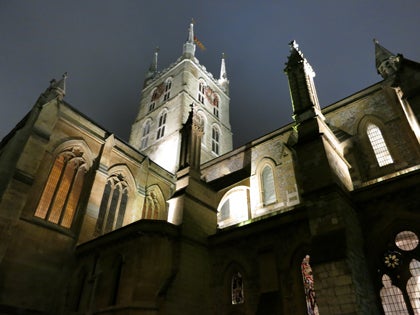Canon PowerShot S100 Review
Canon PowerShot S100 Review
UPDATED: Canon's S100 is a small, pocket-sized advanced compact that packs a larger than average 1/1.7in sensor, a 24-120mm zoom and full manual control. But with the advanced compact market more competitive than ever can the S100 still cut it a year after its launch? The What Digital Camera Canon PowerShot S100 review finds out...
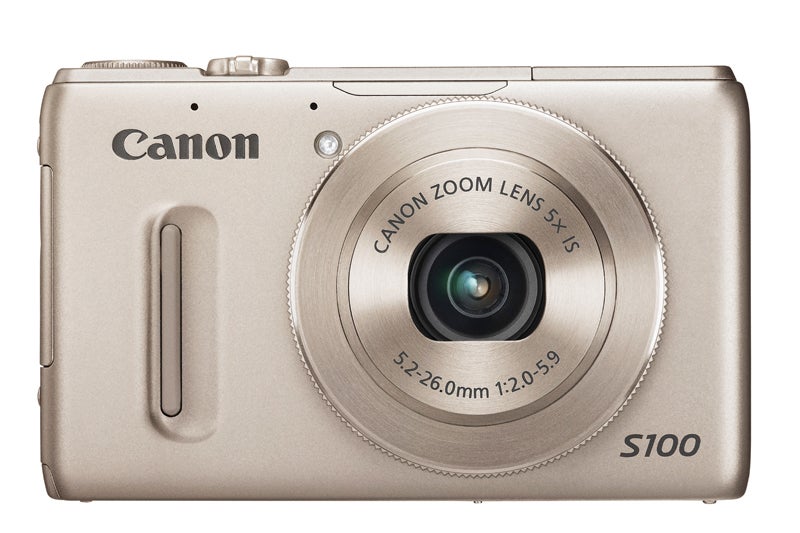
Verdict
Pros
- Front control ring, small size, GPS, image quality
Cons
- No hotshoe or full flash control, expensive, AF-area buried in menu settings
Key Specifications
- Review Price: £429
The advanced compact market has seen plenty of action since
the Canon S100 made its debut towards the end of 2011. Since then we’ve seen
the introduction of the Fuji X10, the Nikon P7700, the Lumix LX7, the Oympus
XZ-2 and the Sony RX100. And of course Canon itself has recently replaced the
S100 with the all-new PowerShot S110, which brings touch-screen control and built-in
Wi-Fi to the party.
One notable trend that has taken hold since the S100 was
launched is that advanced compact sensors are getting larger. Whereas in the
past 1/1.7in or even 1/1.6in sensors were largely considered the norm for an
advanced compact, some newer models launched have upped the ante with bigger sensors.
The Sony RX100, for example, employs a 1in sensor, while the Fuji X10 uses a
2/3in chip. The S100, meanwhile, uses a1/1.7in sensor – exactly the same size
as the Nikon P7700 and Lumix LX7.
Of course sensor size isn’t everything, and there’s a lot more
that goes into making a successful advanced compact. Even by today’s standards,
the S100 remains a well-featured and pocket-friendly advanced compact. Let’s take a look in more detail…
Canon PowerShot S100 review – Features
At the S100’s core is a 12.1-megapixel, 1/1.7in CMOS sensor – the size is larger than an average compact camera and this is a crucial benefit to image quality. Indeed there are only a handful of compacts with such sensors, all of which are considered high-end models. Add to this Canon’s HD system and DIGIC 5 processor – which Canon claims to be six times more powerful than its predecessor – and the S100 should produce top-spec images throughout its ISO 80-6400 range. As well as both Raw & JPEG still images the new CMOS sensor can also capture 1080p HD movies at 24 frames per second.
 Canon PowerShot S100 review sample image – click for full size gallery
Canon PowerShot S100 review sample image – click for full size gallery
The latest processor also speeds things up meaning the S100 can shoot at 2.3fps (up from 1.9fps compared to its predecessor) or, when set to the High-Speed Burst HQ mode, an impressive 8 frame burst can occur in little under a second (at a 9.6fps rate).
Matched up with the sensor, the S100 has a 5x optical zoom lens that ranges from a wide-angle 24mm through to 120mm at the top end. While this may sound rather conservative, it’s a brand new zoom that wipes the slate clean compared to its predecessor and, in context with the competition, is a rangier affair than its peers. An f/2.0 lens at the widest angle slips down to f/5.9 when at 120mm, meaning there’s a dip of 1/3rd a stop of light at the longer zoom settings compared to the previous S95 but a rise in both wideangle and top-end zoom ability. A built-in ND (Neutral Density) filter can also be activated to cut back on three stops of light should the occasion call for it, and a 1/2000th fastest shutter speed means subjects can be frozen in action.
Also new for this release is in-camera GPS (Global Positioning Satellite) technology to track a shot’s location and mark the EXIF data accordingly. The S100 also includes a GPS Logger tracking feature that can follow and plot your route via GPS, even when the camera is switched off. These routes can then be plotted on the provided Map Utility software.
Performance
Canon PowerShot S100 review – Performance
The PowerShot S100 has three main focusing types: Face AiAF which prioritises focus for faces; Tracking AF which will lock on to a moving subject from the centre-spot of the screen; and FlexiZone which allows a single area AF point to be moved around the majority of the screen. The latter is a crucial upgrade that the previous S95 lacked, meaning the S100 offers fuller control over AF-area selection instead of single-point centre AF. However the AF point can’t be moved right to the edges of the S100’s screen and to access resizing/repositioning requires entering the quick menu, selecting the AF option and then pressing the Menu button – we’d really like to see a function button allotted to quick AF-point adjustment.
The camera’s autofocusing is swift and the camera’s AF illuminator lamp useful for dim conditions, while Macro focusing can achieve focus as close as 3cm from the lens (at the widest 24mm setting).
As well as Auto mode and the standard P/S/A/M manual shooting modes the S100 includes both Scene and Effects modes. The latter, located on the main mode dial as per all the other shooting modes, defaults to HDR (High Dynamic Range) though there are a variety of other options too (Nostalgic, Fish Eye, Miniature, Toy Camera, Monochrome, Super Vivid, Poster, Color Accent and Color Swap). When using HDR the camera captures multiple images and this can cause some problems if there’s any camera movement. Indeed a number of images suffered from ghosting even when attempting to hold the camera steady at its fullest 120mm zoom. Considering competitors such as Sony have a Handheld Twilight mode that’s more effective the Canon’s HDR function doesn’t feel as well oiled.
The S100 is squarely aimed at the high-end enthusiast and its manual modes that are made all the more exciting by the f/2.0-5.9 lens. The wide aperture at the widest-angle 24mm setting is very useful and while it’s a shame such brightness hasn’t been maintained throughout the zoom this just wouldn’t be a design possibility from such a small-bodied camera. The S100 balances its physical size with lens performance very well and the 120mm top-end focal length is longer than both the Olympus XZ-1‘s 112mm and Panasonic Lumix LX5‘s 90mm offerings.
For moving pictures the S100’s 1080p24 movie mode is quickly accessible via the one-touch button on the camera’s rear. The quality is top notch and the ability to zoom in and out during recording makes this PowerShot all the more versatile. AF-areas are restricted to Face Detection and Center which is a little disappointing, but the smooth and accurate continuous autofocus means the camera makes light work of shooting.
The inclusion of GPS (Global Positioning Satellite) technology positions the camera towards a more tech-minded audience and the feature does have its perks. The ability to log your position will be helpful for some applications, though the impact on the battery does mean its life will be cut considerably shorter when tagging or tracking is left on.
Image Quality
Canon PowerShot S100 review – Image Quality
The S100’s 1/1.7in sensor means image quality is top notch for a camera in this class. Colour is bright and vivid which makes for stand out shots straight from camera.
However, processing artefacts aren’t eradicated from the camera’s JPEG images, where inspection at full size can show mottled grain in gradient areas and this can affect detail of subjects’ edges.
High ISO shots keep colour noise at bay, and shots up to ISO 1600 maintain a good level of detail thanks to the S100’s all-new sensor. For JPEG-only shooting the option to adjust Noise Reduction between
Low/Standard/High does provide an extra level of user control.
Dynamic range is also improved over the previous S95 model and this means that greater shadow and highlight detail can be retained that’s great to have when tweaking Raw files.
The S100’s 24-120mm lens also provides a good level of sharpness though, to put it in context, we’re not talking about DSLR or CSC standard here.
Purple fringing can be a slight issue towards image edges, though for the most part this is reserved for back-lit subject’s edges.
Overall the S100 is an impressive camera that creates excellent images for a camera of this class – it really is the ultimate compact companion to take anywhere.
Value & Verdict
Canon PowerShot S100 review – Value
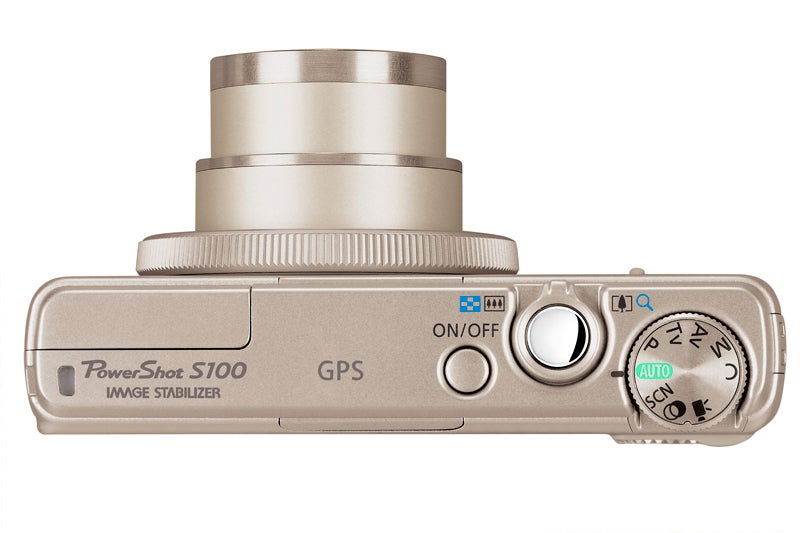
While the £439 launch price undoubtedly made the S100 an
expensive option when it first arrived, the S100’s street price has since fallen to around £300, which
makes it a much more attractive proposition.
Compared to its rivals at the time of its launch, the S100 has held its
value slightly better and is therefore remains a slightly more expensive option than say
the Panasonic Lumix LX5 (£250), the Nikon P7100 (£300), or the Olympus XZ-1
(£260).
Compared to the latest generation of advanced compacts,
however, the S100 offers very good value – just so long as you’re not overly
concerned with having either the very latest model or the largest sensor
possible. For example, as a new release you can expect the Canon S110 to set
you back around £430, while the Lumix LX7 presently costs around £390. The Fuji
X10, meanwhile, has seen its price drop quite considerably since its launch,
with current street prices hovering around the £330 mark. Elsewhere, the
Olympus XZ-2 costs around £480, and the recently launched Nikon P7700 is around
£450.
Canon PowerShot S100 review – Verdict
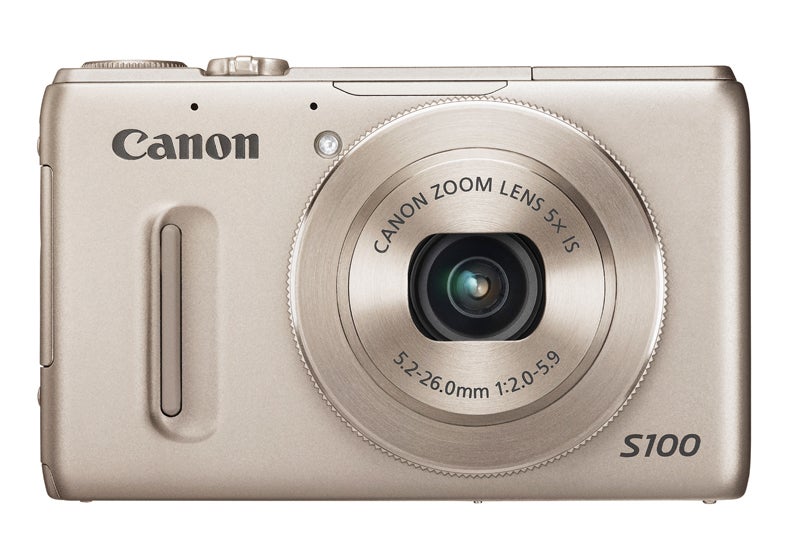
Canon’s PowerShot S100 may not look all too different from its S95 predecessor, but plenty has changed for the better. The latest model is small yet powerful: its body feels robust and the wide-angle 24-120mm f/2.0-5.9 lens is impressive from a camera of such a size.
If there’s anything to try and make a fuss about then the lack of flash control, hit-and-miss HDR and that a little too much menu digging needed for single AF-point adjustment would be our shortlist. Plus the price isn’t too easy on the wallet – but if you want the best then you’ll have to pay out for it.
However, overall the S100 has almost everything right: It provides full manual control that high-end users demand; the front lens ring design makes for quick and easy use; fuller control of the autofocus point rectifies the S95’s single biggest feature omission; pictures are decent thanks to the large (for a compact) 1/1.7in sensor; 1080p movie is great in use; and the bags of other features such as GPS don’t fail to deliver.
If you want a small compact that has it all then look no further than the S100.
Design
Canon PowerShot S100 review – Design
The S100’s small body is dressed in a textured finish as per the EOS 7D DSLR. This gives the camera a metallic-like, high quality feel that’s robust and, thanks to the front grip and rear thumb rest, easy and comfortable to hold.
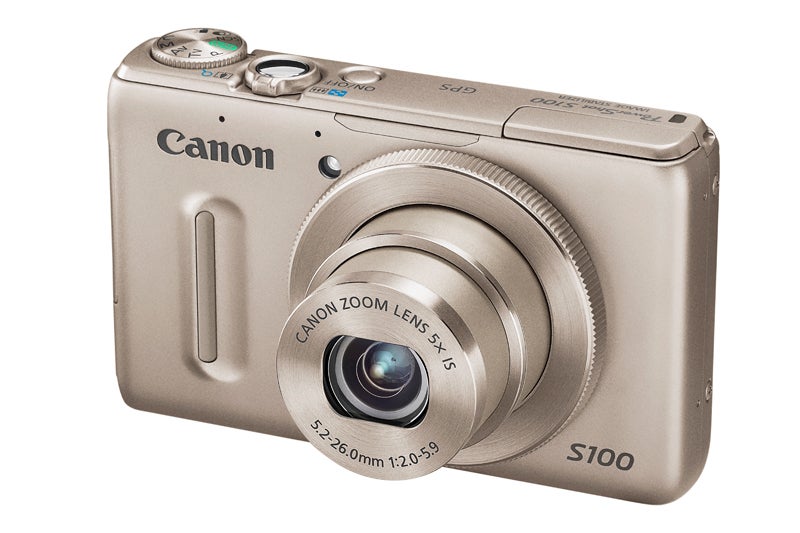 While the PowerShot S100 may look like a standard compact in many respects, there’s a front control ring around the lens that can have a function assigned to it. In Auto mode, for example, it operates a step zoom to speedily jump between 24, 28, 35, 50, 85, 100 and 120mm with great proficiency (it’s very fast), while other modes have a ‘standard’ setting – aperture is altered in Aperture Priority; shutter in Shutter Priority; and ISO in Programme Auto. In any of the manual options pressing the ‘Ring Func.’ Button on the back of the camera reveals a list of options (ISO, Exposure Control, Focus, White Balance, Step Zoom, i-Contrast, Aspect Ratio and Custom) should you wish to re-assign the lens ring’s function. In combination with the rear rotational d-pad and main mode dial on top of the camera the S100 ensures that full, customiseable control is always at your fingertips.
While the PowerShot S100 may look like a standard compact in many respects, there’s a front control ring around the lens that can have a function assigned to it. In Auto mode, for example, it operates a step zoom to speedily jump between 24, 28, 35, 50, 85, 100 and 120mm with great proficiency (it’s very fast), while other modes have a ‘standard’ setting – aperture is altered in Aperture Priority; shutter in Shutter Priority; and ISO in Programme Auto. In any of the manual options pressing the ‘Ring Func.’ Button on the back of the camera reveals a list of options (ISO, Exposure Control, Focus, White Balance, Step Zoom, i-Contrast, Aspect Ratio and Custom) should you wish to re-assign the lens ring’s function. In combination with the rear rotational d-pad and main mode dial on top of the camera the S100 ensures that full, customiseable control is always at your fingertips.
While the S100 doesn’t have a viewfinder or hotshoe like its (much) bigger brother the Canon G12, the rear LCD is 3inches in size and has a 461k-dot resolution. As per all LCD screens brighter sunlight can make viewing difficult, yet Canon’s PureColor II G tempered glass outer layer means the S100 outperforms lesser compacts in this department.
A small pop-up flash provides some control though the ‘medium/maximum’ output doesn’t offer an accurate way of measuring fill flash and no hotshoe means no external flash control. We’d liked to have seen a full flash ability with proper fractional (1/1, 1/2, 1/4, etc.) power control, plus the ability to control external flashes and/or a hotshoe for mounting a more powerful ‘gun.
Trusted Score
Score in detail
-
Value 9
-
Design 9
-
Features 10
-
Image Quality 9
-
Performance 9




